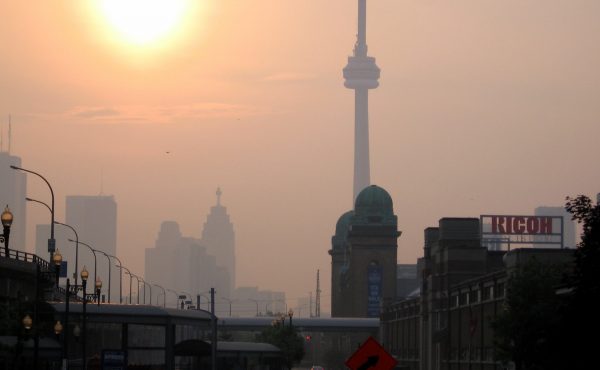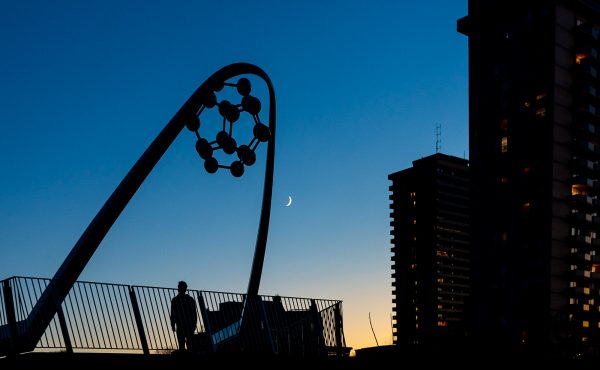
Spacing has Julie Yamin reporting from the two-day Toronto Summit conference.
– – – – – – – – –
Many aspects of the 2007 Toronto Summit were centered on the idea of tranforming Toronto into a green city. The big question posed to every attendee: can we become North America’s greenest city? Someone needs to be the greenest, so why not Toronto.
It’s not like you can turn on a television, read a paper, or listen to the radio in Toronto without hearing some mention of waste management, urban sprawl, green technology, and carbon and greenhouse gas emissions. These ideas have been slowly introduced to Canadians across the country. But what does it mean for this city?
In the past few years we’ve seen a some green initiatives such as the Greenbelt, and the green organic bins implemented in Toronto and the GTA. But Toronto and the GTA are Ontario’s largest producer of waste, sprawl, and gas emissions. With hundreds of thousands of cars coming in and out of the city everyday it’s no wonder the number of smog alert days goes up every year.
Louise Comeau, Director of the Sage Climate Project and former Director of the Federation of Canadian Municipalities, delivered a speech to the group before sending them into discussion. Her speech however, had very little mention of waste management, and focused mainly on greenhouse and carbon gas emissions.
Fact is that the Ontario Government has recently admitted they will not be meeting their 2008 target of a 60 per cent landfill diversion. In 2005, over 18 per cent of the solid waste dumped into Michigan landfills came from Canada, and the majority coming from Toronto. The city needs to begin working harder to continue increasing our landfill diversion percentage, the city is currently at 40 per cent. Our optimistic Mayor would like to see that number reach 70 per cent by 2010.
The organic green bins have been a great help as organic waste accounts for 30 per cent of all household waste, this means about 100,000 tonnes, or more simply put: 2,750 truckloads of organic waste is diverted out of landfills annually. The recent LCBO initiative to allow wine and liquor bottles to be returned for a deposit refund will be another huge step in terms of diverting waste. You can now return empty bottles of Corona, for example, and other clear glass beer bottles — these are all glass and plastic bottles that in the past made their way into landfills. This was brought up at many tables as a good step forward.
But our waste management problem will only get worse if we don’t continue to fight urban sprawl. The GTA population is expected to soar to 10.5 million by 2031, a 43 per cent increase of today’s population. If nothing changes in the near future, this will mean a 50 per cent increase in car ownership, meaning more cars on the roads, meaning more traffic in and out of Toronto, more cars idling in traffic, and yes, a 42 per cent gas emissions increase into our already damaged air. Urban sprawl is also an issue Louise Comeau seemed to skip over during her speech, but it wasn’t forgotten once the table talk began. You could overhear people talking about the positive effect the greenbelt legislation has already had on the region.
It is one thing to create new and innovative ways for residents of Ontario to conserve energy, lower the amount of waste their household produces, and make transit more user friendly, but unless you put a carrot in front of people, they risk not going for it. During her speech, Comeau suggested to “undertake a focused education effort showing citizens the link between energy consumption, climate change and air pollution and how their actions can contribute to a green, clean future for Toronto,†as part of her six-step route to making Toronto, North America’s greenest city. She also felt it was important to demonstrate to the people what risks they are currently exposed to. She says many people know about global warming without actually knowing what it entails.
During the discussion period, one table came up with a waste management reward system for residents. They thought that if residents received a reward for having the smallest amount of solid waste on pickup day, then residents would feel the incentive to reduce their waste. They felt that only a small number of incentives would be needed as Toronto residents seem ready for this kind of paradigm shift. Comeau agreed, saying “the city needs an integrated energy plan and to engage citizens in its development.” According to Comeau, between 1995 and 2005 greenhouse gas emissions from Ontario coal stations has skyrocketed by 90 per cent and is now responsible for 40 per cent of the province’s industrial CO2 emissions.
She says it is time to “broaden our focus from transit and focus on buildings: residential and commercial…with a particular focus on low-income households…63 per cent of Toronto’s greenhouse gas emissions are generated in buildings through the use of electricity and natural gas…in 2004, 4.3 billion cubic metres of gas was consumed.†Comeau would like everyone to stop looking at buildings as consumers but rather as the spine connecting energy supply units like solar PV, solar thermal, cogeneration and geothermal energy systems.
In 1988, Toronto hosted the International Conference on the Changing Atmosphere. After this conference, Toronto declared that by 2005 the greenhouse gas emission level would be 20 per cent below that of the 1988 level. It’s 2007; clearly we didn’t reach this goal. Although we don’t know how far Toronto was from meeting that goal, we were assured the city has made great headway in terms of reducing corporate emissions, it hasn’t however done as well in the citywide fight. Comeau says that “to avoid more than two degrees of global warming requires rapid and deep reductions of 30 per cent by 2020 and from 60 to 80 per cent by 2050. Two degrees of global warming represents two to six degrees average warming in Canada with winter temperatures even higher, especially in the North.â€
She also fears what effects this will continue to have on our daily lives if nothing changes. Heat waves, water quality, water quantity due to lake and river level declines, storm water overflow from increased precipitation, transmission failures, blackouts, flash floods and urban forest damage. She says these risks are both very real in Toronto and will be very costly in terms of infrastructure, health care and the local economy. She quoted Sir Nicholas Stern, former World Bank economist: “the costs of climate change puts at risk five to 20 per cent of global gross domestic product, while the cost of avoiding the problem is only one per cent of the GDP.â€
Comeau’s immediate response solution: Increase Toronto’s tree canopy by 30 per cent. Add more green space through green roofs, permeable surfaces throughout the city to help manage precipitation intensity and slow down storm water runoff. This, she says will help prevent overflow and beach closings, it will provide more shade and help cool the city. It will save energy by shutting off air conditioners, which as we now know, is the leading cause of increased electricity consumption in the summer. She says we can think about gasifying the remaining waste that cannot be recycled to create more energy sources.
She left us with some food for thought. “Is putting in bigger sewer pipes the best way to manage more intense precipitation? Or is the answer to increase green cover in Toronto to slow down the flow of water, increase absorption…and provide habitat and social space?â€
photo by Bouke Salverda




6 comments
All this talk of Toronto becoming the greenest city in North America has me a little queasy.
Why set such lofty goals when as of now the city has taken very few concrete steps towards reaching this?
I’m all for talking about ideas but actions of course will speak louder.
Take the transportation issue for example.
When Toronto starts to actually take (and not just talk about) actual steps towards making this a more car unfriendly city (higher parking fees for bigger polluters, tolls on our major highways etc) maybe then we can afford to talk a little louder and expose our “best in North America” ambitions.
^We should aim lower?
Just a comment on the LCBO bottle return program:
There is no plan in place to move towards the reuse of wine and liquor bottles. Without the reuse aspect, the deposit system is just duplicating what is already done by the blue-box system. Not only is this inefficient, but there is a good chance that the LCBO will stop contributing funds to the blue box program. This is hardly a huge step in the right direction.
Not that we should aim lower, but maybe we should take a deep breath, take it slower and work on some of the smaller steps towards greening ourselves before we spout our mouths off about aiming to be the best. How about more action now and then we’ll talk more later?
It is often too easy to get lost in the rhetoric of large ambitions. We’ve seen this before – a decade ago this country had ambitious intentions of meeting its Kyoto requirements…
The wine/liquor return program makes people feel good but in reality is mostly a duplication of the blue box system. Do I think that more bottles will be returned? Yes. Do I think people will make more car trips to return those bottles? Yes. Are garbage trucks still driving around picking up other stuff in blue boxes ? Yes. Less landfill, dirtier air. Doesnt seem like an improvment to me.
It’s clear that a ‘green Toronto’ really mean archaic thinking like approving the purchase of a $200M land fill site near London, so that Mayor Miller can still ship the garbage out-of-town in the near future…. but, still, just a little closer then were the mess ends up now (i.e., Michigan). That purchase of the Green Lane site south of London also borders a First Nations reserve and the purchase was also approved by the MOE… go figure the rational! “Thank you Madame Minister, lunch is on us,” blurts the Mayor to our Province’s very well Minister of the Environment! How nice to hide the GTA’s refuse problem on Ontario soil this time around… thanks so much for the 50’s approach to disposal. Toronto is about as green as an abandoned PCB disposal yard. We hear he’s trying to show that Chicago and Toronto are about ‘equally green’ –yet another bad GTA joke!